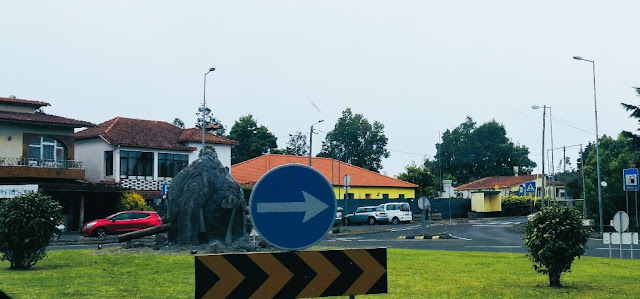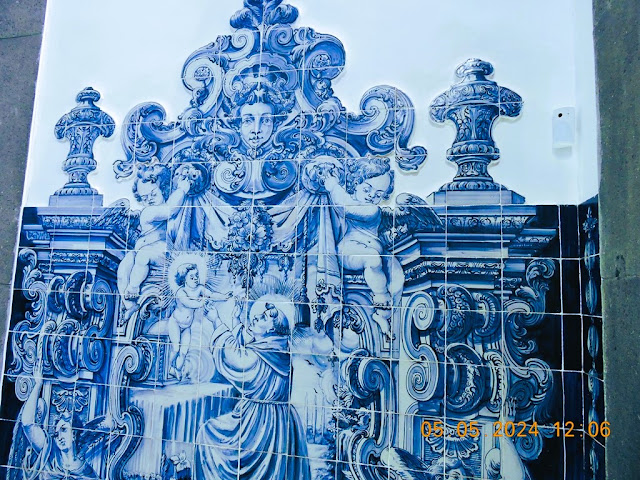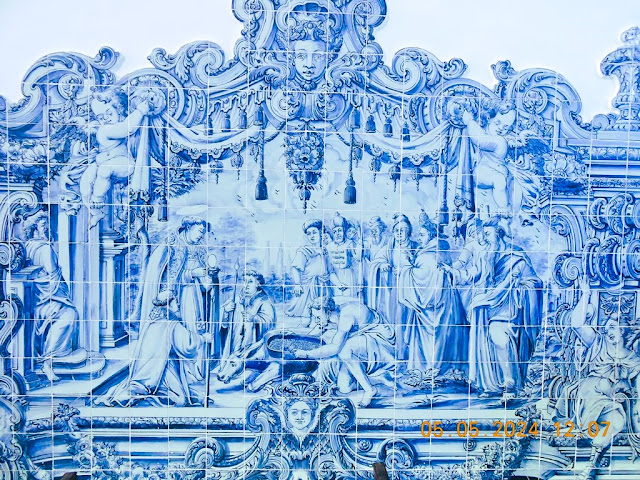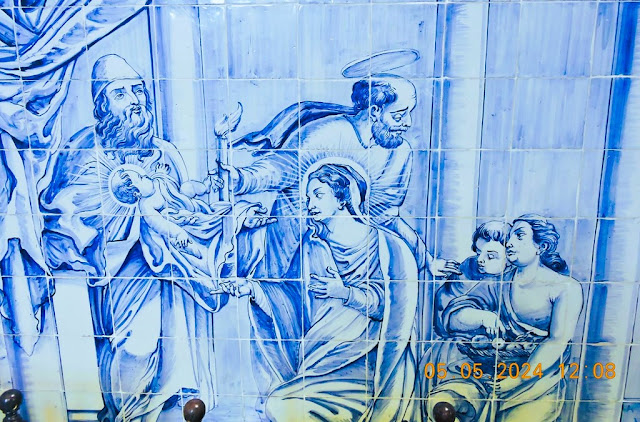
SANTO ANTÓNIO DA SERRA
(Parish of Machico)
32°44′5″N 16°49′35″W
Santo António da Serra is a civil parish in the interior of the municipality of Machico, on the island of Madeira. The parish is adjacent to another in the neighboring municipality of Santa Cruz to the south, also named Santo António da Serra. The population in 2011 was 1,617, in an area of 8.62 km2.
History
The parish name originated from the local adoration of Saint Anthony, and the name is usually shortened to Santo da Serra in conversation.
Settlement of this region happened late, owing to most settlers' preference for coastal lands rather than the rugged interior. It is likely to have occurred during the 16th century, beginning in the area of the parochial church, and progressing to a point where Gil de Carvalho ordered the construction of two chapels for the resident population. During this century, a primitive temple located on the main church site existed, under the jurisdiction of the vicar of Machico. After the 17th century, a dispute arose between the vicars of Machico, Santa Cruz, and Água de Pena over their jurisdictions: consequently, the Bishop of Funchal, Lourenço de Távora, to resolve the dispute, took the chapel (and its associated lands) under his protection, and therefore, episcopal jurisdiction (which it continues to fall, under the Mitra do Funchal).
The bishopric governor, António Alfredo de Santa Catarina, in 1836, annexed the parish of Água de Pena to Santo da Serra, transferring the ecclesiastical seat to the latter, under the parish of Santo da Serra e de Água de Pena. But, Santo da Serra was eventually restored by regal charter in 1848, taking with it the locality of Achada do Barro, and making it an autonomous parish of Machico.
In 1852, certain areas of the municipality Machico, specifically lands in Santo da Serra, were annexed to the municipality of Santa Cruz, provoking protests. Under the initiative of the Sectary General of the District, António Lopes Barbosa de Albuquerque, who reunited the respective representatives of the "warring" groups at Casa dos Romeiros in Santo da Serra, where an accord was brokered that divided Santo da Serra between the two municipalities of Machico and Santa Cruz.
During the reign of Queen Maria I, the monarch established lands to be used for the inhabitants of Porto Santo: these tracts were to be distributed freely to those who wanted to leave the island. This followed an economic crisis on the island in the 18th century, putting many in a state of poverty and malnutrition. By regal decree, dated 18 December 1768, the lands were referred to as the Aldeia da Rainha (English: village/hamlet of the Queen), and many tried to adapt to the new environment. But, the climate (both humid and cold) forced many to abandon the colony, resulting in it being reverted to the jurisdiction of Machico.
In the 19th century, Santo da Serra was a ferment of religious agitation, instigated by the Scottish physician Robert Kalley, who opened a medical practice in the parish, providing counselling free of charge to the residents. At the same time that he treated his patients, the doctor proselytized his Protestant Calvinist ideals and religion, creating conflict within the community, reaching as far as the municipalities of Machico and Santa Cruz. Consequently, this tumult caused the authorities to establish processes against individuals preaching new doctrines or religious ideals in the community, sending many to prison and forcing Dr. Kalley to leave the island.
Geography
The parish of Santo António da Serra, located in the interior of the southern coast of Madeira, pertains to the municipality of Machico, confronted in the north and east by the parish of Porto da Cruz, west by the municipality of Santa Cruz, and by extent 20 kilometers from Funchal, the regional capital. It is situated in the rough plateau, around 700 meters altitude, overlooking Machico, characterized by forest vistas of chestnut, acacia, and elderberry trees that were acquired by many English to construct farms during settlement.
The principal places (Portuguese: lugares) in the parish are: Ribeira de Machico, Igreja, Fajã dos Rolos, Fajã das Vacas, Margaça, Lombo das Faias, Lamaceiros and Achada do Barro.
Economy
The main activity is predominantly agricultural, and specifically the raising of dairy or beef cattle. The traditional routines are preserved in the parish and the cultivation of fields, have been restricted by the geography, resulting in the use of techniques employed by older generations. The use of natural fertilizers and resources found in the local area and local dependency has prevailed. Along with the incept commercial activity, commonly used to support the local market, the parish has also expanded into hostelry to expand local revenues, while the Campo de Golfe da Madeira (the oldest golf course on Madeira, has already attracted many of the important athletes of the sport
Quinta do Santo da Serra
32.724147, -16.818367
Located in the parish of Santo António da Serra, Quinta do Santo da Serra is a public park with a large green area. This is a superb recreational area on Madeira's east coast, much appreciated by the island's families, school population and visitors to this region.
The Quinta do Santo da Serra was built in the 19th century by the Blandy family. Designed according to the English colonial style, it was acquired in 1975 by the now-extinct Junta Geral do Distrito Autónomo da Madeira. From then on, its name was changed to 'Quinta da Junta' and it became the official holiday residence of the President of the Regional Government.
Today, it is a public leisure and recreation space, with various attractions. At Quinta do Santo da Serra you can find animals such as peacocks, fallow deer, and Garrano horses, a mini-golf course and a tennis court, a picnic park or a viewpoint overlooking the municipality of Machico, Ponta de São Lourenço, and even the island of Porto Santo.
You can also admire its rich flora, which includes exotic species such as azaleas, rhododendrons and camellias.
SANTO DA SERRA GOLF CLUB
32.721907, -16.803858
Although the history of this course takes us back to 1937, when it was inaugurated, it was in 1991 that it was transformed into what we know today, when it was redesigned by the famous architect Robert Trent Jones Senior.
Since then, the Santo da Serra Golf Club has been recognised as one of the most extraordinary courses in Europe.
A short distance from the city of Funchal and less than 15 minutes from the Madeira International Airport, this golf course offers a wide view over the Machico bay.
Here, players have access to exuberant natural settings, marked by the unavoidable presence of the Atlantic Ocean and green mountains.
With 9003 metres and 27 holes, all characterised by generous fairways and greens, you will find various levels of difficulty at Santo da Serra Golf Club, for both relaxed matches and more attractive challenges.
It is, therefore, the perfect place for beginners and professionals alike - it is no coincidence that it hosted the Madeira Island Open, part of the European PGA Tour.
Playing in what is truly a botanical garden, with its rich flora and four lakes, is an experience filled with refinement, serenity and fun.
Details
Santo da Serra Golf Club is a 27-hole, 9003 metres course. It provides an unrivalled playing experience, with excellent conditions and green surroundings.
CONTACTS
Clube de Golfe do Santo da Serra - Santo António da Serra
9200-152 Machico
(+351) 291 550 100
reservations@santodaserragolf.com
PARISH CHURCH OF
SANTO ANTONIO DA SERRA
(P) 32.724347, -16.819236
The Igreja Matriz de Santo Antônio da Serra was built on the site where there was a 16th-century chapel. Later it was transformed into a parish church, and the changes to it ended in 1857. This church was dedicated to Saint Anthony and is associated with some legends. The feast of Saint Antonio is celebrated on the Sunday following June 13th (St. Antonio's Day). The church is known for its famous tiles. As well as the famous painting of the parish's patron saint, Saint Antonio.
💝💝💝💝💝
SEARCH IN
MACHICO MUNICIPALITY
Return to mainland Portugal and
to the Azores and Madeira islands

































































































































No comments:
Post a Comment